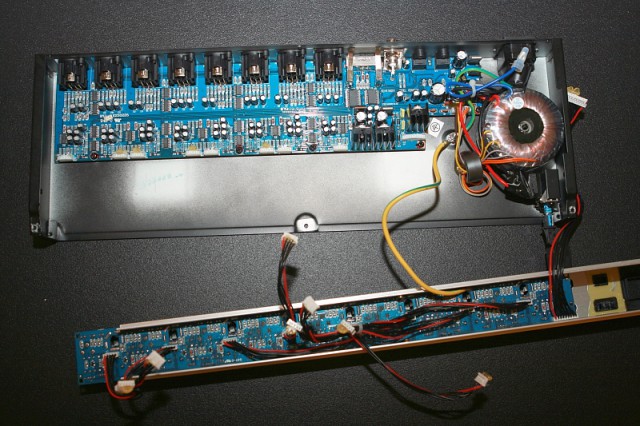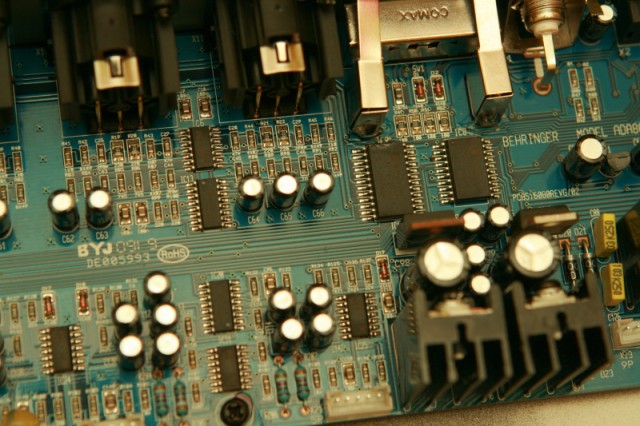Hi there !
I just got a brand new Behringer ADA8000 and, after a short test, I’ve decided to open the toy.
I’ll post here my findings as soon as they surface.
If you have any questions, please leave a comment (quick, until I’ll close the patient).
Preamplifier section: every channel is made with two A970 GR 90 low noise audio amplifier transistors. After that there are two W1G (P8) SMD transistors. I’m not so good on SMD transistor markings, but my best guess would be BC847 type transistor (general purpose transistor).
From here, the signal path is wired through an unshielded 10cm wire to the main board to 074C made bye ST (Low noise J-FET input quad operational amplifier) .
The transistor preamplifier section is a typical differential amplifier configuration, found in any operational amplifier.
There are 8 074C’s, 4 on the input stage and 4 on the output stage. Looks like two adjacent channels are sharing the same operational amplifier (crosstalk problems?).
Back to the input stage, after the operational amplifiers we have AL1101G ADC. After that, AL1401 AG will convert digital data to ADAT signal.
On the output stage, from AL1402 AG ADAT to digital converter, we have 4 AL1201 G DAC stereo converters, then 4 074C operational amplifiers, then XLR analog outputs.
I also see 5 (?) 339 quad voltage comparators. Looks like those are used for the clip LED (note: from my experience with other similar products, the clip led should lit about 1-2 dB before clip. On the ADA8000 looks like the clip led will lit when the signal is already clipping. Maybe biasing the reference on those comparators would make them more useful…).
Short component description (you may find datasheets online):
* AL1401 AG OptoGen converter: “The AL1401A OptoGen interface is designed to accept four stereo pairs of audio data and produce the data stream appropriate for the Alesis ADAT optical format, U.S. patent number 5,297,181.”
* AL1402G OptoRec converter : “The AL1402 OptoRec interface is designed to decode the ADAT optical data stream and produce four stereo pairs of audio data. Alesis ADAT U.S. patent number 5,297,181.”
* AL1101G ADC 107dB: “The AL1101 stereo ADC is a high performance 24-bit analog to digital audio converter. Dynamic range is 107dB (Aweighted). The sensible pinout and easy user interface are unprecedented. The part has an internal high quality phase locked loop that eliminates the need for external high frequency clocks.”
* AL1201G DAC 107dB: “The AL1201 stereo DAC is a high performance 24-bit digital to analog audio converter. Dynamic range is 107dB (Aweighted). The sensible pinout and easy user interface are unprecedented. The part contains an internal high quality phase locked loop that eliminates the need for external high frequency clocks.”
* A970GR90 (preamp): PNP low frequenciy, low noise transistor
Here you can find Gyraf audio’s diagram. From what I’ve seen, not sure about all the component values, but the diagram principle is pretty acurate.


Hello there. My ADA8000 has died on me for the second time. Same problem as the first time, but first time it was in warranty period and it was repaired by Thomann. Now I have to do it myself and I don’t have much of a clue.
It’s a rev G model. I switched it on and the lights shined dimly, with half of the usual brightness. I thought it was just my impression but I tried to record throught it and it wasn’t working. I tried to find some info in the internet and found this post.
I brought the device to an uncle of mine who is very technically skilled. We have opened the thing this afternoon and checked the voltages of the regulators. Every tension seems to be ok but one, the +5va, which measured at the phantom led indicators is reduced to 3,39v. We have followed the tracing and arrived to the T19 transistor in reverse of the main board, but we are not able to find such component in the schematics we own. Could you help me with the issue? Thanks in advance for your time!
At this moment we do not own the schematic involved in your version. However, why don’t you replace the transistor with any BC compatible transistor and see what’s happening?